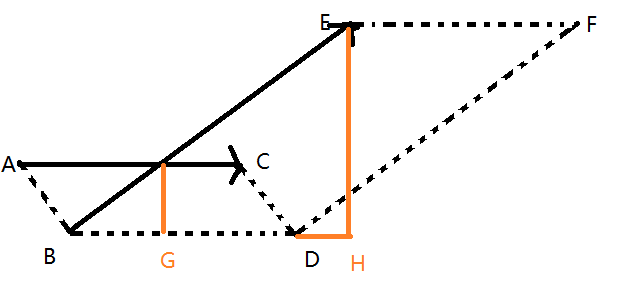P4196 [CQOI2006]凸多边形 半平面交
\(\color{#0066ff}{题目描述}\)
逆时针给出n个凸多边形的顶点坐标,求它们交的面积。例如n=2时,两个凸多边形如下图:

则相交部分的面积为5.233。
\(\color{#0066ff}{输入格式}\)
第一行有一个整数n,表示凸多边形的个数,以下依次描述各个多边形。第i个多边形的第一行包含一个整数mi,表示多边形的边数,以下mi行每行两个整数,逆时针给出各个顶点的坐标。
\(\color{#0066ff}{输出格式}\)
输出文件仅包含一个实数,表示相交部分的面积,保留三位小数。
\(\color{#0066ff}{输入样例}\)
2
6
-2 0
-1 -2
1 -2
2 0
1 2
-1 2
4
0 -3
1 -1
2 2
-1 0
\(\color{#0066ff}{输出样例}\)
5.233
\(\color{#0066ff}{数据范围与提示}\)
100%的数据满足:2<=n<=10,3<=mi<=50,每维坐标为[-1000,1000]内的整数
\(\color{#0066ff}{题解}\)
半平面交裸题
开两个结构体储存点和线
根据输入方式,自己定义直线方向,那么半平面的方向就确定了
代码中规定的方向是向量左边
两个向量求交(\(AC, BE\))

做出这样的平行四边形
过E作EH,过p(交点)作PG
显然BPG,BEH相似,而且作的两条线为平行四边形的高
又因为两个平行四边形的底相等
所以高之比等于相似比?
通过叉积可以获得面积比(相似比)
然后\(p = B + k * v_2\)
以上为向量求交点
我们维护一个双端队列
每次来一跳新的直线,把收到影响的队首,队尾弹出
最后队列里就是有效直线
把相邻的交点都求出来,那么这个多边形的面积就是半平面交的面积
#include<bits/stdc++.h>
using namespace std;
#define LL long long
LL in() {
char ch; int x = 0, f = 1;
while(!isdigit(ch = getchar()))(ch == '-') && (f = -f);
for(x = ch ^ 48; isdigit(ch = getchar()); x = (x << 1) + (x << 3) + (ch ^ 48));
return x * f;
}
const int maxn = 505;
double eps = 1e-8;
int T(double x) {
if(x > eps) return 1;
if(x < -eps) return -1;
return 0;
}
struct node {
double x, y;
node(double x = 0, double y = 0): x(x), y(y) {}
node operator + (const node &b) const {
return node(x + b.x, y + b.y);
}
node operator - (const node &b) const {
return node(x - b.x, y - b.y);
}
double operator ^ (const node &b) const {
return x * b.y - y * b.x;
}
double jj() const {
return atan2(y, x);
}
node operator * (double b) const {
return node(x * b, y * b);
}
}e[maxn];
struct line {
node from, to;
line(node from = node(), node to = node()): from(from), to(to) {}
double jj() const {
return (to - from).jj();
}
bool operator < (const line &b) const {
return T(jj() - b.jj()) == 0? T((to - from) ^ (b.to - from)) > 0 : T(jj() - b.jj()) < 0;
}
}a[maxn], q[maxn];
int n, head, tail, ji;
node to(line i, line j) {
node x = i.to - i.from, y = j.to - j.from, z = j.from - i.from;
return j.from + y * ((z ^ x) / (x ^ y));
}
bool jud(line x, line y, line z) {
node p = to(x, y);
return ((z.to - z.from) ^ (p - z.from)) < 0;
}
void work() {
std::sort(a + 1, a + ji + 1);
int cnt = 0;
for(int i = 1; i <= ji; i++) {
if(T(a[i].jj() - a[i - 1].jj())) cnt++;
a[cnt] = a[i];
}
head = 1, tail = 0;
q[++tail] = a[1], q[++tail] = a[2];
for(int i = 3; i <= cnt; i++) {
while(head < tail && jud(q[tail - 1], q[tail], a[i])) tail--;
while(head < tail && jud(q[head + 1], q[head], a[i])) head++;
q[++tail] = a[i];
}
while(head < tail && jud(q[tail - 1], q[tail], q[head])) tail--;
while(head < tail && jud(q[head + 1], q[head], q[tail])) head++;
q[tail + 1] = q[head];
ji = 0;
for(int i = head; i <= tail; i++) e[++ji] = to(q[i], q[i + 1]);
}
int main() {
n = in();
for(int i = 1; i <= n; i++) {
int F = in();
for(int j = 1; j <= F; j++)
e[j].x = in(), e[j].y = in();
e[F + 1] = e[1];
for(int j = 1; j <= F; j++) a[++ji] = line(e[j], e[j + 1]);
}
work();
double ans = 0;
e[ji + 1] = e[1];
if(ji > 2) for(int i = 1; i <= ji; i++) ans += (e[i] ^ e[i + 1]);
printf("%.3f", fabs(ans) / 2.0);
return 0;
}
----olinr


 浙公网安备 33010602011771号
浙公网安备 33010602011771号